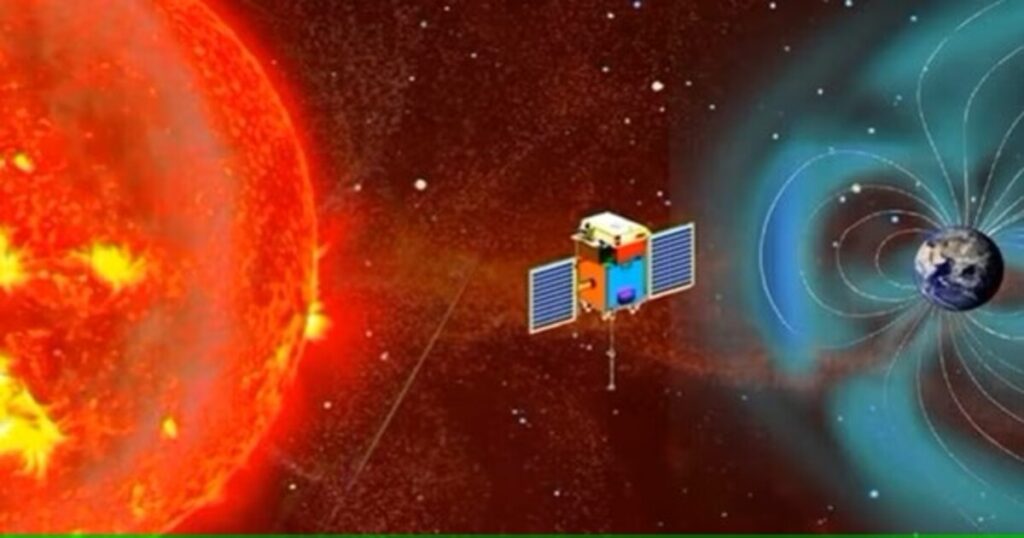Explore India’s Aditya L1 Solar Mission milestone, a leap forward in space exploration. Witness the dawn of a solar revolution, unraveling unprecedented opportunities in solar research and interplanetary studies.

In a groundbreaking achievement for the Indian Space Research Organisation (ISRO), the Aditya L1 solar mission has successfully entered its final manoeuvre, reaching the first Sun-Earth Lagrangian point (L1) on January 6 at 4 pm. The spacecraft, launched on September 2 last year, has undergone four earth-bound manoeuvres and a Trans-Lagrangean Point 1 Insertion (TL1I) manoeuvre, positioning it in a halo orbit around L1, approximately 1.5 million km from Earth.
Unraveling the Mysteries of the Sun’s Corona
The primary objective of the Aditya L1 mission is to observe the Sun’s corona and comprehend its extreme heat from the unique vantage point of a halo orbit around L1. The Lagrange Point represents a region where gravitational forces between the Earth and the Sun reach equilibrium, providing a stable observational position. Although absolute neutralization is not entirely achievable due to the gravitational influence of celestial bodies like the Moon, Mars, and Venus, the L1 point offers an ideal location for scientific study.
ISRO’s chairman, S Somanath, expressed enthusiasm about the mission’s scientific potential, stating, “Looking forward to a lot of scientific outcomes from Aditya-L1.” The successful execution of the final manoeuvre marks a significant milestone for India’s space exploration endeavors.
International Recognition and Acclaim
NASA Scientist Dr Amitabha Ghosh acknowledged India’s burgeoning presence in the scientific arena, especially after the success of Aditya L1. He remarked, “India is now in most areas of scientific significance,” highlighting the country’s remarkable progress in planetary science, culminating in achievements like the Aditya L1 mission.
The milestone has garnered praise from various quarters, including CP Joshi, BJP’s state president in Rajasthan, who lauded the efforts of Indian scientists. “Today, India and our scientists have achieved a huge success. I express my gratitude to everyone,” said Joshi, emphasizing the significance of the achievement.
Former President Ram Nath Kovind hailed ISRO’s accomplishment as a testament to the growing space prowess of the country. He took to X to express his sentiments, writing, “ISRO achieves another milestone by successfully placing India’s maiden solar probe Aditya-L1 in Halo orbit near Lagrange Point L1, to study the Sun.”
Aditya L1: A Milestone in Bharat’s Journey through Space
Union Home Minister Amit Shah echoed the sentiment, emphasizing that the mission marked “another milestone in Bharat’s journey through space.” He commended the achievement, stating, “Our first solar observatory #AdityaL1 reaches its destination in space. It is a momentous event in history that takes us closer to our civilizational goal of achieving human welfare through excellence in science and technology.”
As Aditya L1 orbits the Sun from the L1 point, it will study the Sun’s wonders without interruptions caused by eclipses and occultation. The successful completion of the mission positions India as a significant player in the field of solar research and space exploration.
Conclusion
The successful culmination of the Aditya L1 mission signifies a remarkable achievement for ISRO and India’s space exploration endeavors. Positioned at the L1 point, the spacecraft is poised to unravel the mysteries of the Sun’s corona, contributing valuable insights to scientific understanding. As India continues its journey through space, milestones like Aditya L1 underscore the country’s growing prominence in the field of space exploration and scientific research.